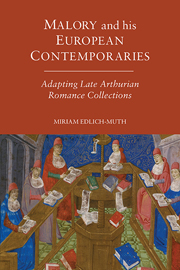Book contents
- Frontmatter
- Dedication
- Contents
- Colophon
- Acknowledgements
- Introduction
- 1 The Adaptation Process
- 2 Style and Narrative Strategy
- 3 Chronological and Genealogical Structures in the Morte Darthur, the Buch der Abenteuer and the Tavola Ritonda
- 4 Narrative Plot Development in the Morte Darthur, the Buch der Abenteuer and the Tavola Ritonda
- 5 ‘The Best Knight in the World’: Adapting Character Constellations
- Conclusion
- Appendix: Note on the Texts and Manuscripts
- Bibliography
- Index
- Arthurian Studies
4 - Narrative Plot Development in the Morte Darthur, the Buch der Abenteuer and the Tavola Ritonda
Published online by Cambridge University Press: 05 March 2014
- Frontmatter
- Dedication
- Contents
- Colophon
- Acknowledgements
- Introduction
- 1 The Adaptation Process
- 2 Style and Narrative Strategy
- 3 Chronological and Genealogical Structures in the Morte Darthur, the Buch der Abenteuer and the Tavola Ritonda
- 4 Narrative Plot Development in the Morte Darthur, the Buch der Abenteuer and the Tavola Ritonda
- 5 ‘The Best Knight in the World’: Adapting Character Constellations
- Conclusion
- Appendix: Note on the Texts and Manuscripts
- Bibliography
- Index
- Arthurian Studies
Summary
As established in the previous chapter, the organic ‘rise, prime and decline’ structure of the core Arthurian narrative invites compilers and re-writers to insert material into the central sections of the established plotline. In doing so, they succeed in incorporating varied material whilst keeping the indispensable narrative elements surrounding the rise and fall of the Arthurian world in place. As a result, it is these central sections that depart most noticeably from the narrative style and structure of earlier sources such as the Lancelot–Grail cycle. This is mainly because the introduction of ‘timeless’ new adventures into the central parts of the core Arthurian narrative necessarily puts different characters centre stage and detracts from the plot development tracking the rise and decline of characters more central in the older sources. Due to these changes, and possibly as a result of texts based directly or indirectly on oral traditions also being incorporated, overall plot development is altered in decisive ways. This tendency becomes increasingly pronounced as the chronog-raphies develop away from their twelfth- and thirteenth-century models, suggesting that the process of adaptation gives rise to texts with specific structural features that accumulate as time goes by. This chapter will continue to look at the Tavola Ritonda (1320s), the Morte Darthur (1470s) and the Buch der Abenteuer (1470s) as early and late examples of how narrative cohesion and the development of suspense are altered in the central sections of Arthurian chronographies.
- Type
- Chapter
- Information
- Malory and his European ContemporariesAdapting Late Arthurian Romance, pp. 87 - 115Publisher: Boydell & BrewerPrint publication year: 2014

